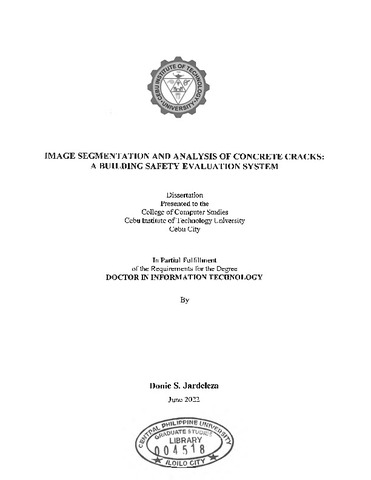Image segmentation and analysis of concrete cracks: A building safety evaluation system
| dc.contributor.adviser | Aliac, Chris Jordan | |
| dc.contributor.author | Jardeleza, Donie S. | |
| dc.coverage.spatial | Iloilo | en_US |
| dc.date.accessioned | 2023-01-10T03:18:03Z | |
| dc.date.available | 2023-01-10T03:18:03Z | |
| dc.date.issued | 2022-07 | |
| dc.identifier.citation | Jardeleza, D. S. (2022). Image segmentation and analysis of concrete cracks: A building safety evaluation system (Unpublished Doctoral dissertation). Cebu Institute of Technology University, Cebu City. | en_US |
| dc.identifier.uri | https://hdl.handle.net/20.500.12852/2421 | |
| dc.description | Abstract only | en_US |
| dc.description.abstract | One of the factors that determine a city to be highly urbanized is through its strong foundation of structural safety implementations. It demands for a well-established skills of structural specialists in maintaining the quality and reliability of these man-made structures. This study aims to understand and interpret information taken from captured images of concrete cracks. Specifically, it investigates collected images of concrete structure deformities by extracting pixel related details. In this relation, images contain useful features that convey every shades of color value intensities it displays. Known as the “Queen City of the South”, Iloilo City is popular for its Spanish colonial churches and old houses. Regular monitoring of buildings are often undertaken using traditional procedures such as visual inspection and manual recording, making it tedious in the long run. The need to develop a building safety evaluation system to aid in the systematic approach of performing the routine assessment of any structure. The methodology applied through Iterative Modeling was the segmentation of captured concrete crack images and categorized accordingly through clustering using Partitioning Around Medoids (PAM). By using a public dataset containing 20,000 observations to serve as training sets, the pixels extracted were classified by a formulated crack severity category (CSC) which were specified as cutoffs. Percentage values were calculated and those were below a certain light intensity threshold in a pixel were constituted to be part of a crack. Results have shown that k-medoids algorithm was able to minimize the distance between points labeled within a cluster as well as the distances between each of the clusters. These evidence in the results have dramatically decreased the false positives and misclassification of the images. Having known all the related features in the identification of concrete cracks can support building evaluators and regulatory organizations in maintaining and preserving the quality of building construction at the same time, it will encourage the conceptualization of new insights and recommend improvements for better decision making endeavors. | en_US |
| dc.format.extent | x, 60 leaves | en_US |
| dc.language.iso | en | en_US |
| dc.subject.ddc | GSL Theses 004.72 J282 | en_US |
| dc.subject.lcsh | Image analysis | en_US |
| dc.subject.lcsh | Image segmentation | en_US |
| dc.subject.lcsh | Buildings--Protection | en_US |
| dc.subject.lcsh | Concrete--Analysis | en_US |
| dc.subject.lcsh | Building--Safety measures | en_US |
| dc.subject.lcsh | Structural design--Safety measures | en_US |
| dc.subject.lcsh | Concrete--Evaluation | en_US |
| dc.title | Image segmentation and analysis of concrete cracks: A building safety evaluation system | en_US |
| dc.type | Dissertation | en_US |
| dcterms.accessRights | Not publicly accessible | en_US |
| dc.description.bibliographicalreferences | Includes bibliographical references | en_US |
| dc.contributor.chair | Maravillas , Elmer | |
| dc.contributor.committeemember | Feliscuzo, Larmie S. | |
| dc.contributor.department | College of Computer Studies | en_US |
| dc.description.degree | Doctor in Information Technology | en_US |
Fichier(s) constituant ce document
Ce document figure dans la(les) collection(s) suivante(s)
-
Dissertations [1]


